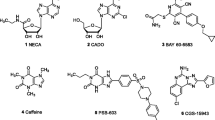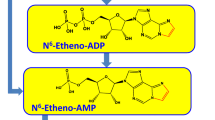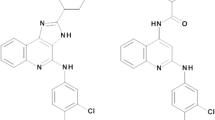Summary
8-Cyclopentyl-1,3-dipropylxanthine (PD 116,948) is a very potent, very A1-selective adenosine antagonist, with a K i of 0.46 nM in 3H-CHA binding to A1 receptors in rat whole brain membranes and 340 nM in 3H-NECA binding to A2 receptors in rat striatal membranes. Its 740-fold A1-selectivity is the highest reported for an adenosine antagonist. 3H-PD 116,948 (117 Ci/mmol) was prepared by reduction of the diallyl analog. 3H-PD 116,948 bound to a single site in rat whole brain membranes, with a B max of 46 pmol/g wet weight and K d of 0.42 nM. Nonspecific binding was extremely low, amounting to about 3% of total binding under standard conditions and less than 1 % when higher tissue concentrations were used. Affinities of compounds for inhibition of 3H-PD 116,948 binding were highly consistent with an A1 adenosine receptor. Antagonists were equally potent in 3H-PD 116,948 binding and in 3H-CHA binding, while agonists were consistently about 12-fold more potent in 3H-CHA binding. Hill coefficients were 1.0 for antagonists and about 0.65 for agonists. 3H-PD 116,948 should be a useful antagonist ligand for adenosine A1 receptors.
Similar content being viewed by others
References
Blicke FF, Godt HC Jr (1954) Reactions of 1,3-dimethyl-5,6-diaminouracil. J Am Chem Soc 76:2798–2800
Bruns RF, Daly JW, Snyder SH (1980) Adenosine receptors in brain membranes: Binding of N6-cyclohexyl[3H]adenosine and 1,3-diethyl-8-[3H]phenylxanthine. Proc Natl Acad Sci USA 77: 5547–5551
Bruns RF, Daly JW, Snyder SH (1983) Adenosine receptor binding: Structure-activity analysis generates extremely potent xanthine antagonists. Proc Natl Acad Sci USA 80:2077–2080
Bruns RF, Lu GH, Pugsley TA (1984) Binding of 3H-NECA to a subtype of A2 adenosine receptor in rat striatal membranes. Soc Neurosci Abstr 10:957
Bruns RF, Lu GH, Pugsley TA (1985) Towards selective adenosine antagonists. In: Stefanovich V, Rudolphi K, Schubert P (eds) Adenosine: Receptors and modulation of cell functions. IRL Press, Oxford, pp 51–58
Bruns RF, Lu GH, Pugsley TA (1986a) Characterization of the A2 adenosine receptor labeled by [3H]NECA in rat striatal membranes. Mol Pharmacol 29:331–346
Bruns RF, Fergus JH, Badger EW, Bristol JA, Santay LA, Hays SJ (1986b) PD 115,199: An antagonist ligand for adenosine A2 receptors. Naunyn-Schmiedeberg's Arch Pharmacol 335:64–69
Daly JW, Padgett W, Shamim MT, Butts-Lamb P, Waters J (1985) 1,3-Dialkyl-8-(p-sulfophenyl)xanthines: Potent water-soluble antagonists for A1- and A2-adenosine receptors. J Med Chem 28:487–492
Fergus JH, Bruns RF, Badger EW, Bristol JA, Hartman JD, Santay LA, Hays SJ, Huang CC (1986) Adenosine receptor binding of the A1-selective antagonist [3H]PD 116,948. Fed Proc 45:800
Goodman RR, Cooper MJ, Gavish M, Snyder SH (1981) Guanine nucleotide and cation regulation of the binding of [3H]cyclohexyladenosine and [H]diethylphenylxanthine to adenosine A1 receptors in brain membranes. Mol Pharmacol 21:329–335
Green RD (1984) Reciprocal modulation of agonist and antagonist binding to inhibitory adenosine receptors by 5′-guanylylimido-diphosphate and monovalent cations. J Neurosci 4:2472–2476
Hamilton HW, Ortwine DF, Worth DF, Badger EW, Bristol JA, Bruns RF, Haleen SJ, Steffen RP (1985) Synthesis of xanthines as adenosine antagonists, a practical quantitative structure-activity relationship application. J Med Chem 28:1071–1079
Lee KS, Reddington M (1986) 1,3-Dipropyl-8-cyclopentylxanthine (DPCPX) inhibition of [3H]N-ethylcarboxamidoadenosine (NECA) binding allows the visualization of putative non-A1 adenosine receptors. Brain Res 368:394–398
Linden J, Patel A, Sadek S (1985) [125I]Aminobenzyladenosine, a new radioligand with improved specific binding to adenosine receptors in heart. Circ Res 56:179–284
Lohse MJ, Lenschow V, Schwabe U (1984) Two affinity states of Ri adenosine receptors in brain membranes: Analysis of guanine nucleotide and temperature effects on radioligand binding. Mol Pharmacol 26:1–9
Schwabe U, Trost T (1980) Characterization of adenosine receptors in rat brain by (−) [3H]N6-phenylisopropyladenosine. Naunyn-Schmiedeberg's Arch Pharmacol 313:179–187
Schwabe U, Ukena D, Lohse M (1985) Xanthine derivatives as antagonists at A1 and A2 adenosine receptors. Naunyn-Schmiedeberg's Arch Pharmacol 330:212–221
Williams M, Braunwalder A, Erickson TJ (1986) Evaluation of the binding of the A-1 selective adenosine radioligand, cyclopentyl-adenosine (CPA), to rat brain tissue. Naunyn-Schmiedeberg's Arch Pharmacol 332:179–183
Williams M, Risley E (1980) Biochemical characterization of putative central purinergic receptors by using 2-chloro[3H]adenosine, a stable analog of adenosine. Proc Natl Acad Sci USA 77:6892–6896
Yeung S-M H, Green RD (1983) Agonist and antagonist affinities for inhibitory adenosine receptors are reciprocally affected by 5′ guanylylimidodiphosphate or N-ethylmaleimide. J Biol Chem 258:2334–2339
Yeung S-M H, Green RD (1984) [3H]5′-N-ethylcarboxamide adenosine binds to both Ra and Ri adenosine in rat striatum. Naunyn-Schmiedeberg's Arch Pharmacol 325:218–225
Author information
Authors and Affiliations
Additional information
Send offprint request toR. F. Bruns at above address
Rights and permissions
About this article
Cite this article
Bruns, R.F., Fergus, J.H., Badger, E.W. et al. Binding of the A1-selective adenosine antagonist 8-cyclopentyl-1,3-dipropylxanthine to rat brain membranes. Naunyn-Schmiedeberg's Arch Pharmacol 335, 59–63 (1987). https://doi.org/10.1007/BF00165037
Received:
Accepted:
Issue Date:
DOI: https://doi.org/10.1007/BF00165037




